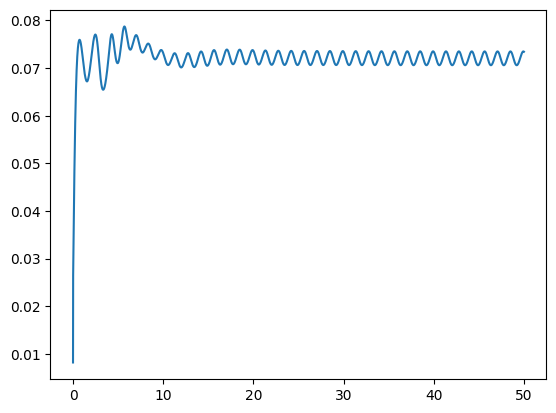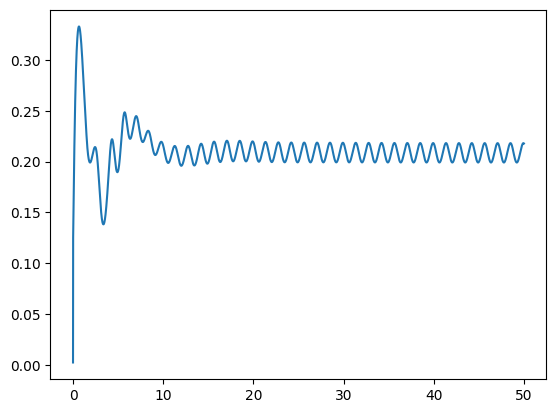26.4. NACA airfoil#
The NACA airfoil series is a set of standardized airfoil shapes, which became widely used in the design of aircraft wings. See https://en.wikipedia.org/wiki/NACA_airfoil
We use the Python code naca.py by Dirk Gorissen, and adapted by Xaver Mooslechner and Edoardo Bonetti to Netgen-OCC geometry.
from ngsolve import *
from netgen.occ import *
from ngsolve.webgui import Draw
import matplotlib.pyplot as plt
from naca import naca4
import numpy as np
def occ_naca_profile(alpha = 12, h=0.03):
xs, ys = naca4("2412", 600)
pnts = list (zip ( xs, ys, (0,)*len(xs) ))
curve = Wire(SplineApproximation(pnts))
wing = Face(curve)
wing.edges.name = "wing"
wing.edges.maxh = h
rect = Rectangle(6, 2).Face().Move((-1.5, -1, 0))
rect.edges.name = "wall"
rect.edges.Min(X).name="inlet"
rect.edges.Max(X).name = "outlet"
wing = wing.Rotate(Axis((0,0,0), Z),-alpha)
air = rect - wing
return air
with TaskManager():
mesh = Mesh(OCCGeometry(occ_naca_profile(alpha=12, h=0.01), dim=2).GenerateMesh(maxh=0.1))
mesh.Curve(3)
Draw(mesh);
print ("ne = ", mesh.GetNE(VOL))
ne = 4155
def NavierStokes(R, tau , tend):
V = VectorH1(mesh, order=1, dirichlet="wall|wing|inlet")
V.SetOrder(TRIG, 3)
V.Update()
Q = H1(mesh, order=1)
X = V*Q
drag_x_test = GridFunction(X)
drag_x_test.components[0].Set(CoefficientFunction(
(-1, 0)), definedon=mesh.Boundaries("wing"))
drag_y_test = GridFunction(X)
drag_y_test.components[0].Set(CoefficientFunction(
(0, -1)), definedon=mesh.Boundaries("wing"))
time_vals, drag_x_vals, drag_y_vals = [], [], []
u, p = X.TrialFunction()
v, q = X.TestFunction()
stokes = 1/R*InnerProduct(grad(u), grad(v))+div(u)*q+div(v)*p - 1e-10*p*q
a = BilinearForm(X, symmetric=True)
a += stokes*dx
a.Assemble()
# nothing here ...
f = LinearForm(X)
f.Assemble()
# gridfunction for the solution
gfu = GridFunction(X)
# parabolic inflow at inlet:
uin = CoefficientFunction(((1-y)*(1+y), 0))
gfu.components[0].Set(uin, definedon=mesh.Boundaries("inlet"))
# solve Stokes problem for initial conditions:
inv_stokes = a.mat.Inverse(X.FreeDofs())
res = f.vec.CreateVector()
res.data = f.vec - a.mat*gfu.vec
gfu.vec.data += inv_stokes * res
# matrix for implicit Euler
mstar = BilinearForm(X, symmetric=True)
mstar += (u*v + tau*stokes)*dx
mstar.Assemble()
inv = mstar.mat.Inverse(X.FreeDofs(), inverse="sparsecholesky")
# the non-linear term
conv = BilinearForm(X, nonassemble=True)
conv += (grad(u) * u) * v * dx
# for visualization
sceneu = Draw(Norm(gfu.components[0]), mesh, "velocity", sd=3)
#scenep = Draw(Norm(gfu.components[1]), mesh, "pressure", sd=3)
# implicit Euler/explicit Euler splitting method:
t = 0
i = 0
with TaskManager():
while t < tend:
# print("t=", t, end="\r")
conv.Apply(gfu.vec, res)
res.data += a.mat*gfu.vec
gfu.vec.data -= tau * inv * res
time_vals.append(t)
drag_x_vals.append(InnerProduct(res, drag_x_test.vec))
drag_y_vals.append(InnerProduct(res, drag_y_test.vec))
t = t + tau
i = i+1
if i % 30 == 0:
sceneu.Redraw()
#scenep.Redraw()
plt.plot(time_vals, drag_x_vals)
plt.show()
plt.plot(time_vals, drag_y_vals)
plt.show()
R = 1800
tau = 2e-3
tend = 50
NavierStokes(R, tau, tend)


